From the State Board
Gardening has become quite popular during the quarantine and therapeutic to many during this challenging time. We are also reminded by ecologists about the importance of native plants for a vibrant ecosystem and a healthy planet. Maybe you have spent many hours over the last few months planting natives and weeding invasives. Your garden is probably looking nearly perfect by now. It might be a good time to explain to your neighbors why you have been gardening.
One way to spread the word about the importance of native plants is to have your property certified as a native plant habitat. GNPS offers two levels of certification. For the Silver Level, one third of your property should be planted in native plants and for the Gold Level, native plants should represent two thirds of the property. Once you fill out the online application and pay a fee of $30, someone will visit your garden. If you meet all the requirements, you will receive a sign to place in your yard. What a great way to promote native plants in your neighborhood!
Every year we certify an average of ten gardens. The certification is not limited to residences. Parks, school grounds, church property and other public places can qualify. For example, at the Georgia Institute of Technology there is a living landscape that surrounds a living building. The Kendeda Building is powered by solar panels, filters rain water harvested from the roof, and has a ceiling made from reclaimed lumber. These features and many other strict sustainable practices make it an award-winning living building. Encircling the Kendeda Building is a garden consisting of only native plants. Among them are sedges (Carex pensylvanica and Carex cherokeensis), cardinal flower (Lobelia cardinalis), various goldenrods (Solidago), pepperbush (Clethra alnifolia), and more. In the bog garden are cattails (Typha latifolia) and pickerelweed (Pontederia cordata). On the rooftop, native grasses and blueberries are growing. Every plant has a place and purpose. Honey bees help complete the sustainable environment. Thanks to Shan Arora, director of the building, and Steve Place, horticulturalist for the Kendeda plantings, who contacted GNPS. Congratulations on earning the Gold Level of Native Plant Habitat Certification! The building and grounds are models of what the world needs to regenerate our fragile ecosystem.
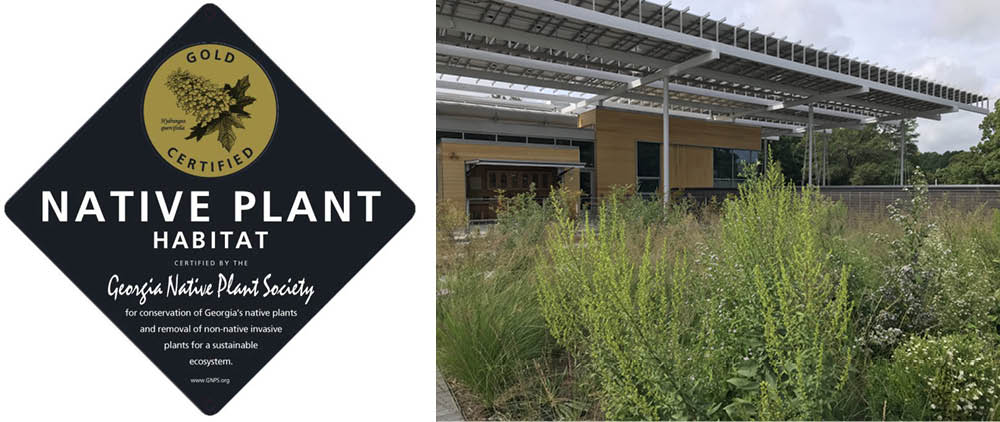 Please check out the GNPS Native Plant Habitat Certification page for all the details of certification, and read about members across the state who have certification!
And as always, if you have questions or would like to reach us about other matters, send email to board@gnps.org.
Chapter News: Coastal Plain
Coastal Plain Chapter Fall Meeting Set for November 7th
Mary Alice Applegate
The 2020 CPC GNPS fall meeting is coming together as an online event, set for Saturday, November 7th, from 9:00 to 11:00 a.m. The meeting will begin with a short business session conducted by CPC President Heather Brasell, with reports primarily issued via email beforehand.
The online program will include visual presentations about public native plant / pollinator garden projects in three settings: a state park (Gail Farley), a city park (Karan Rawlins), and an elementary school (Marilynne Marshall). The “how to do it” sessions cover such topics as making a pollinator garden more acceptable looking for the public (Greg Huber), propagating native plants for plant sales (Amy Heidt), plant rescue strategies (Erin Cork), and using native plants as hedges (Heather Brasell). The fall meeting closes with a virtual field trip to the Cay Creek Wetland Interpretive Center, along with management challenges of the wetland interpretive center. Our virtual field trip guide will be Eamonn Leonard.
While we really want to be together physically for this meeting, we are planning for the most engaging online session possible, with brief presentations and varied speakers and topics of interest. CPC members can expect a meeting announcement soon. Anyone who needs technical assistance on using video conferencing can ask for help before the meeting.

DNR Wildlife Biologist Eamonn Leonard (left) leads CPC GNPS President Heather Brasell through the six plant communities found at the Cay Creek Wetland Interpretive Center in Midway, Georgia.
Coastal Plain Chapter Plant Sales
Amy Heidt
The Coastal Plain Chapter’s spring/summer plant sales in Tifton have gone extremely well in spite of the COVID-19 restrictions. We began a strictly online sales promotion via our Chapter Facebook page and emails to members and interested nonmembers. Sales began the first of April and continued through August. Plants were delivered every two weeks as needed.
Our sales were a great success. We sold more native plants for landscapes this season than in years past when we sold exclusively at the local farmer’s market. To add to this success, the majority of our sales were to nonmembers of the chapter and we may have picked up a few members along the way as we distributed applications at plant pickup. Inquiries about our sales came from as far away as North Georgia, the coast and Florida (unfortunately these could not be filled due to transport restrictions and licensing).
To help support our local farmer’s market, some members have volunteered to sell plants at the Fall opening beginning in October, since they will now be open October through December. Members who helped with growing and selling plants include Paul Sumner, Heather Brasell, Mary Alice Applegate, Marilynne Marshall, Karan Rawlins, and Mary Beth Cary. We want to give a heartfelt thank you for your support of chapter funding and spreading native plants in the landscapes of the Coastal Plain.
Plants not sold will be used to refurbish gardens at schools, Fulwood Park and other projects in the coastal plain as needed. Many thanks are given to all of the people who have supported our native plant efforts by placing native plants in their landscapes. The birds, bees and butterflies thank you too.
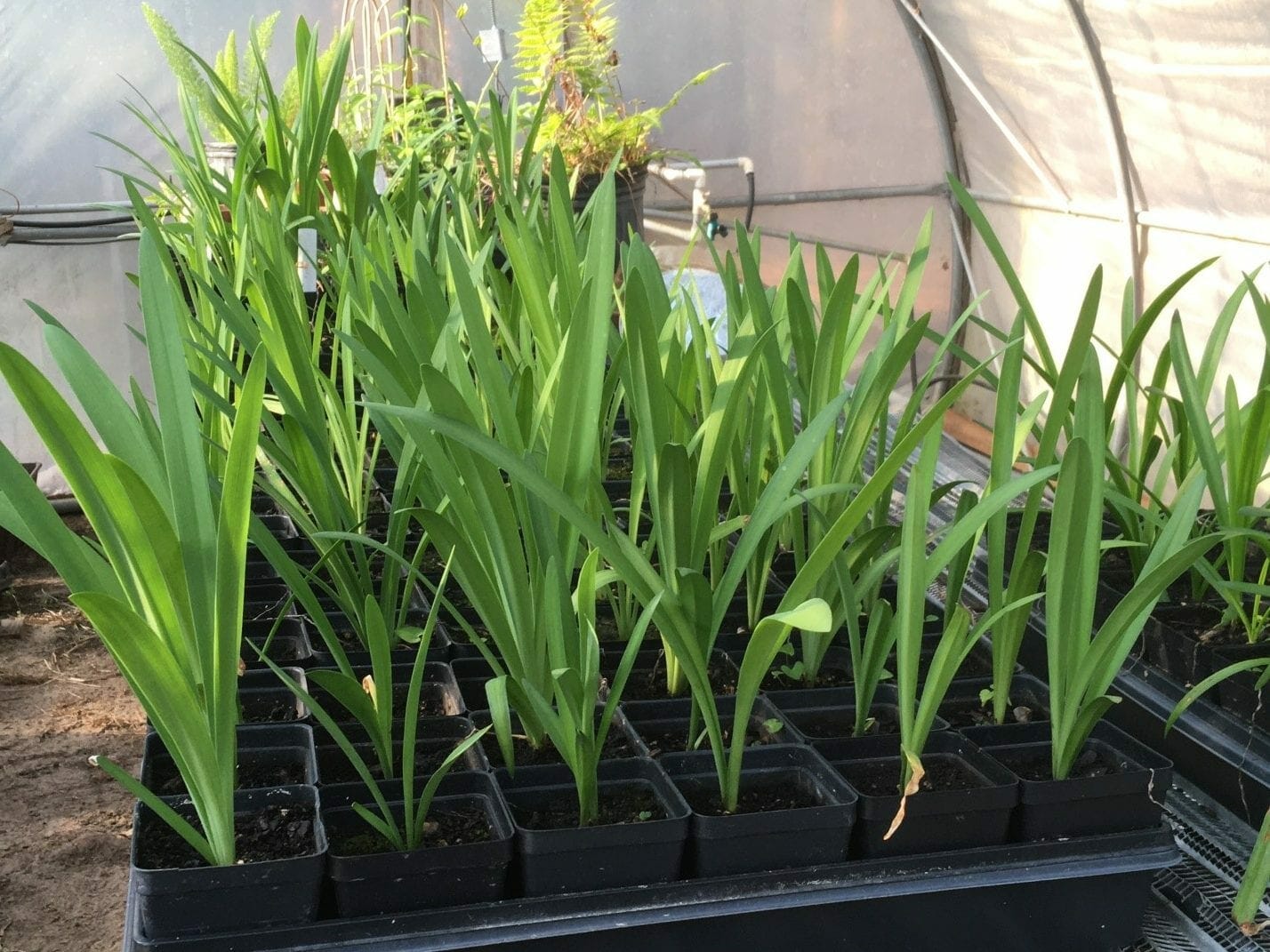
Spider lilies in the greenhouse (Hymenocallis spp.).
Native Plant Garden Establishment Requires Diligence
Mary Alice Applegate
We all know the challenge to planting any garden is the upkeep involved over time. In Tifton, installing over 250 native plants (over 27 species) on a cool fall morning was very exciting and enjoyable; watering and weeding in the hot, muggy months — not so much, especially for non-aficionados.
As the native plant garden at Fulwood Park in Tifton turns one year old in November, the pressure for regular maintenance is great, since the garden surrounds a new dog park with many daily visitors. Public expectations require a careful balancing of a “wild” look versus a traditional orderly, manicured look. Park visitors are accustomed to seeing the tall pines and trimmed non-native azaleas that have defined the park for decades.
Key to the establishment of the Fulwood Park native plant garden has been the consistent watering provided by the City’s public works / park personnel. Their commitment started with a weekly watering schedule that began in November 2019 and bumped up to twice a week in the summer months. Keeping the beds weeded was the Coastal Plain Chapter’s commitment. It has involved quarterly work days and also individual efforts in-between. Fortunately, several CPC chapter members live nearby and visit the park frequently.
Challenges have come from uninvited plants establishing themselves within the garden. Some “guests” have likely come from the soil amendment, from purchased nursery plants, and other unidentified sources. Several plant visitors are robust natives like beggarweed (Bidens pilosa), pokeweed (Phytolacca americana), and morning glory vines (Ipomoea species), that have tried to dominate the natives we planted. The morning glory’s tendency to wind around plants makes its removal more testy. All weeding has been by hand, with only one nuisance plant, bermudagrass (Cynodon species) calling for a careful spraying of herbicide.
Not all plants have thrived, so adjustments are being considered. Many of the inkberry shrubs (Ilex glabra) have not survived, though several inkberry are thriving in an area less shaded by pines. Landscape Architect and UGA Associate Professor Katherine Melcher and other CPC members are discussing replacement plants to serve as a framing backdrop and provide evergreen color. Replacement plants under consideration are dwarf wax myrtle (Myrica cerifera 'Don’s Dwarf' or 'Suwannee Elf'), evergreen blueberries (Vaccinium myrsinites or Vaccinium darrowii), and Georgia calamint (Clinopodium georgianum) or Ashe’s calamint (Clinopodium asheii).
CPC members Katherine Melcher, Karan Rawlins, Amy Heidt, Paul Sumner, Marilynne Marshall, Mary Alice Applegate and Amy Blackmarr have continued the momentum felt on the November 2019 planting day, when over 25 volunteers showed up with shovels, trowels and gloves. With so many dedicated community partners and the public enjoying the new dog park and adjacent native plant garden, the CPC members are happy to invest time and expertise to ensure the garden’s success.
 Left: CPC member Marilynne Marshall tends to native plants at Tifton’s Fulwood Park Native Plant Garden, June 2020. Left: CPC member Marilynne Marshall tends to native plants at Tifton’s Fulwood Park Native Plant Garden, June 2020.
Center: CPC member Karan Rawlins clips selected coneflower (Echinacea purpurea) seed pods, and in the background morning glory vines (Ipomoea species) are overwhelming native wisteria (Wisteria frutescens).
Right: The weeding crew on September 12th are CPC members (l-r) Karan Rawlins, Marilynne Marshall, and Amy Blackmarr. Photos by Mary Alice Applegate.
Second Annual Great Georgia Pollinator Census
Erin Cork
August 21-22 marked the second annual Great Georgia Pollinator Census, and many Georgians spent parts of their weekend paying a little more attention to the often overlooked presence of pollinating insects in their gardens. The Coastal Plain Chapter partnered with DNR biologists to host a guided census in conjunction with this event, inviting the public to join them for two mornings of data collection and insect and native plant appreciation.
The statewide citizen science project is coordinated by University of Georgia Cooperative Extension and was developed last year with several goals in mind: to gather data on pollinator insect populations, to foster pollinator habitats, and to increase entomological literacy about pollinator insects. Gaskins Forest Education Center in Alapaha, Georgia once again hosted the guided census at their pollinator garden, and DNR biologists Erin Cork and Tony Kroeger provided training and assistance to attendees. While the weather was decidedly gray (and gray and wet on day two), ten participants collected 43 independent 15-minute counts which were submitted to the statewide database.
Our top-performing plant species last year included mountain mints (Pycnanthemum) and rosinweeds (Silphium), as well as snow squarestem (Melanthera nivea) and swamp milkweed (Asclepias incarnata). This year, we saw a different suite of flowering plants in peak bloom, and the highest insect counts were associated with sunshine mimosa (Mimosa strigillosa), rosinweeds (once again), and spotted bee balm (Monarda punctata). On the second day, activity was highest on a grass, big bluestem (Andropogon gerardii). Gray skies resulted in fewer butterflies this year, shifting the focus to the diversity of hardworking bees, wasps, and flies that dominated the counts.
 Left to right: Laura Garey, Mary Alice Applegate, Small bee on obedient plant (Physostegia virginiana). Left to right: Laura Garey, Mary Alice Applegate, Small bee on obedient plant (Physostegia virginiana).
Living Fence for Pollinator Garden at Crooked River State Park
Gail Farley
An ongoing challenge for the Pollinator Restoration Project is preventing well-meaning Crooked River State Park host volunteers from mowing inside our bee meadow. Shortly after DNR documented a newly-emerged, state-rare, and endangered species, dwarf pawpaw (Asimina pygmaea), it got mowed down. Another flower gem, Florida paintbrush (Carphephorus corymbosum), with an elongated flower stem, also got mowed down.
Hence the problem solver — a living fence. First on my list was a 'pokey' plant — Adam's needle (Yucca filamentosa). Then a bright, 'HELLO, Here I am!' ground cover — dune sunflower (Helianthus debilis). As a grass is a must for a living fence, Muhly grass (Muhlenbergia capillaris), was added to the list.
The ‘pokiest of pokey’ plants, Eastern prickly pear cactus (Opuntia humifusa), is now being propagated from a mother plant growing inside the park. Once a good root system has developed, it will be transplanted into our living fence. A special benefit of this cactus is that it’s a favorite food of gopher tortoise.
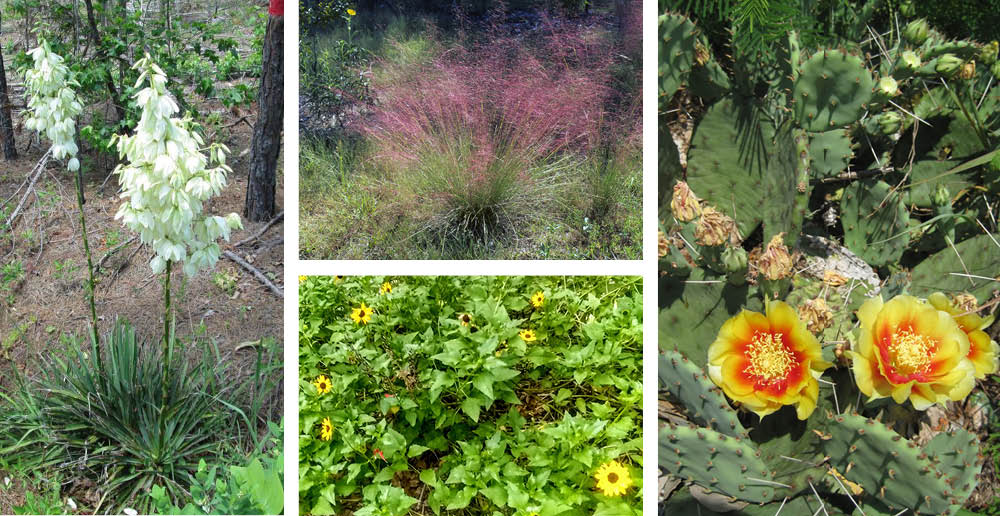 Left: Adam's needle (Yucca filamentosa), photo by David Stephens, Bugwood.org. Top center: Muhly grass (Muhlenbergia capillaris). Bottom center: Dune sunflower (Helianthus debilis). Right: Eastern prickly pear cactus (Opuntia humifusa). Left: Adam's needle (Yucca filamentosa), photo by David Stephens, Bugwood.org. Top center: Muhly grass (Muhlenbergia capillaris). Bottom center: Dune sunflower (Helianthus debilis). Right: Eastern prickly pear cactus (Opuntia humifusa).
Plant Spotlight: Blue Mistflower
Ellen Honeycutt
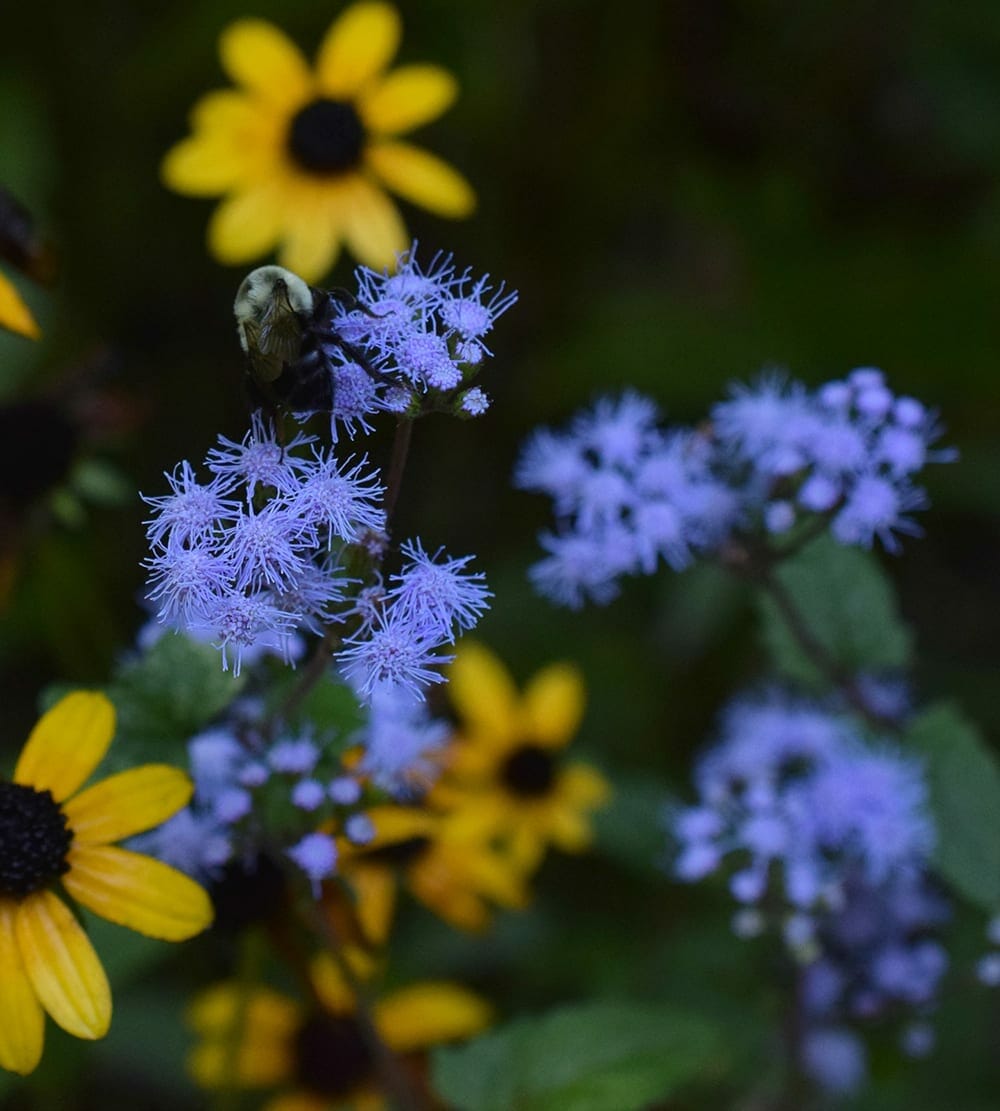
Blue mistflower (Conoclinium coelestinum).
Blue mistflower (Conoclinium coelestinum) is a fall-blooming perennial that I have a love-hate relationship with (or perhaps slightly annoyed is more accurate than hate). This aggressively-spreading perennial is fairly shallow-rooted, allowing it to skim across the surface and make a home anywhere it can find a little opening. I spend all spring pulling it out only to fall in love with it again this time of year. The specific species name (coelestinum) refers to the beautiful blue color: sky-blue or heavenly.
Native throughout Georgia, this perennial grows 2-3 feet tall. Stems are often purplish, and the toothed leaves are opposite along the stem. It is a member of the Asteraceae family but it lacks showy ray flowers. Several tiny flowers are clustered together on each flower head, several of which are clustered together in terminal clusters—an arrangement that is perfect for the many species of butterflies that visit it.
Some folks still think of it by its former name: Eupatorium coelestinum. It is very similar looking to all the Eupatorium species as well as to white snakeroot (Ageratina altissima) which is blooming now as well. One of its common names is hardy ageratum, a reference to its resemblance to the annual plant known as ageratum (Ageratum houstonianum). Old-fashioned gardeners knew our native as dependable, and it was a popular passalong plant between friends. This time of year you might find it in ditches near old homes. There is some near me where two country roads meet at a stop sign; it makes me smile every fall to see it there. If you need some—I’ll bet you know a friend willing to share (especially in the spring!).

Monarch on blue mistflower.
Logging Impacts on Wildlife Habitat
Heather Brasell
Last month I wrote about impacts of logging on conservation of forested ecosystems. In this article, I want to address impacts of logging in planted pine stands on wildlife. In a recent discussion, a plant enthusiast claimed that “logging destroys all wildlife habitat.” On the contrary, I maintain that logging creates wildlife habitat – ecosystems rich in diversity of native plants that meet the needs of a wide range of animals.
First, wildlife management guidelines are full of “it depends” recommendations. Different animals occupy different habitats. Even a single animal may need several types of habitat – for food, water, and shelter. Forest management practices, including logging, have different impacts on different animals. In general, the goal for wildlife managers is to use practices that benefit the most species of plants and animals, and to avoid using practices that harm the most species. Special practices to protect or promote species of concern are beyond the scope of this article.
At the landscape level, biologists usually like to see a mosaic of different types of ecosystems. Forest management is one of the ways to create and maintain this mosaic. In much of the Coastal Plain, the dendritic pattern of ephemeral drains, intermittent streams, and permanent rivers naturally breaks up the landscape. Poorly drained bottoms, occupied by mixed hardwoods and pines, provide cover for many animals and good habitat for some (such as amphibians). In order to protect water quality, prevent erosion, and conserve wildlife habitat, logging operations are severely restricted in these areas. Logging is prohibited in wetlands and restricted in Streamside Management Zones along rivers, streams and drains. Logging operations should follow Best Management Practices (BMP) to help protect wildlife habitat as well as soil and water quality. The BMPs provide specific requirements for logging practices, such as constructing stream crossings to mitigate impacts on wildlife. Crossings should not impede migration of aquatic animals, logging debris should be removed from streams, shade trees should be retained along drains and streams, and particular care should be taken to avoid disturbing areas for spawning fish, breeding and nesting areas for waterfowl, or mussel beds.
Most forest operations are restricted to the better drained upland areas, which are usually broken up into smaller areas for different management operations. Planted pine trees have a typical crop rotation of 25-35 years. To spread both the costs and the income, different stands are harvested and replanted at different times. This automatically creates a landscape mosaic of early succession, midrotation, and mature stands. To ensure additional habitat diversity, stands of planted pines on my property are broken into blocks of about 40 acres, where pines are different ages, or thinned and burned at different times. This allows animals to easily move to another stand after disturbance. Wildlife never have far to go to get to dense cover or different habitat.

Landscape mosaic of managed pine stands interspersed with cypress ponds, drains and poorly drained bottom land along the Alapaha River (blue). Google Earth image, Map data: Google.
On the other hand, habitat fragmentation is a common concern. Habitat connectivity is important to allow animals to move freely with protected cover. As I established smaller management blocks on my property, I made sure wildlife corridors were retained, connecting one cypress swamp or hardwood drain to another.
This mosaic of habitats should include plenty of areas with early-succession herbaceous understory. The herbaceous understory has very high species diversity and provides preferred habitat for a wide range of animals. The fire-climax longleaf-wiregrass community is often touted as having 150-300 species of groundcover plants per acre, more breeding birds than other forest types in southeastern US, and about 60% of amphibian and reptile species found in the southeast. Although there is less diversity in pine plantations than natural communities, long rotations between planting and harvesting (typically 25-35 years) allow many plant species to reestablish fairly quickly and thrive. Many of the plant species are adapted to survive disturbance. They may have seeds that survive for many years in the soil or they may have deep tap roots that resprout after fire or mechanical damage.
At every wildlife management training I’ve been to, the biologist’s mantra is “thin and burn.” Burning alone resets succession by preventing the development of woody shrubs and saplings. Unlike wildfires, prescribed fires seldom harm animals. The fire moves so slowly that animals can easily escape. In addition, herbaceous vegetation regenerates rapidly after the fire with lush, highly nutritious sprouts. However, without thinning, the overstory canopy continues to develop, allowing less light on the ground. Shade-tolerant woody shrubs and hardwood trees replace the herbaceous understory, and the carrying capacity for many animal species decreases.
Whereas thinning rejuvenates the understory, clearcutting resets the entire process of succession. Pioneer species thrive for a few years, taking advantage of the disturbance to reproduce rapidly, and developing seeds that will stay viable in the soil for a long time waiting for the next disturbance. Clearcutting removes the trees, but it doesn’t destroy wildlife habitat. Deer love the new growth from root sprouts from the woody shrubs and trees and the herbaceous pioneer plants that rapidly occupy the site. It may not look pretty to us, but a healthy smörgåsbord has arrived.
Logging may disrupt nests of ground-nesting birds like turkey and quail, but these species can re-nest. In spite of individual nest losses, opening up the canopy improves the carrying capacity for the overall population. Other species, like gopher tortoises, reproduce slowly and are more easily impacted by logging. Foresters and landowners concerned with wildlife management mark each gopher tortoise burrow so logging equipment can avoid running over them. After my recent thinning operation, I checked on the burrows after logging and found most were undisturbed, while several were covered with debris, but none had been driven over.
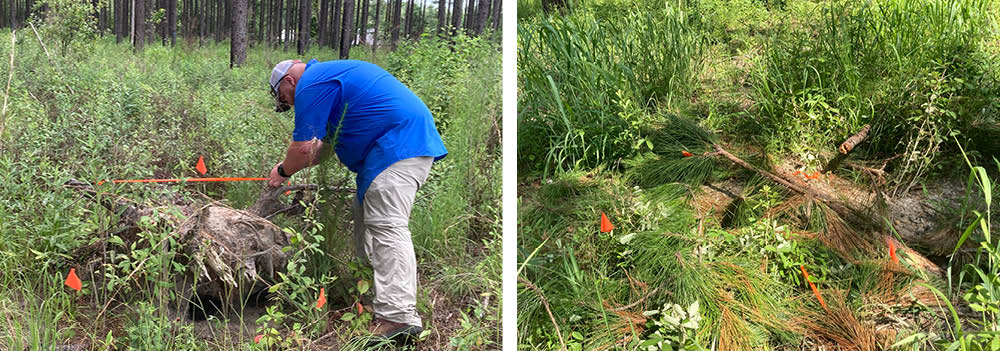
Gopher tortoise burrows marked before thinning and with debris after logging.
Logging decks, where logs are loaded onto trucks, are usually left with a huge pile of logging debris. I’ve seen many insects, birds, snakes, mammals, gopher tortoises, and amphibians making their homes in debris piles. However, landowners should burn these piles because they provide a good place for predators to make dens – good for predators, but very bad for ground-nesting birds and small mammals. Burning the debris piles also reduces risks from wildfire and insects and diseases. If the piles are burned from the upwind side only, the pile burns slower and less intensely. Animals in the piles can easily escape. After the debris piles have been burned, the area provides valuable wildlife openings. Biologists recommend 5-10% of property should be in wildlife openings, including both native plants and food plots. They also recommend leaving standing dead trees (snags) to provide food, nesting, shelter, and lookout site.
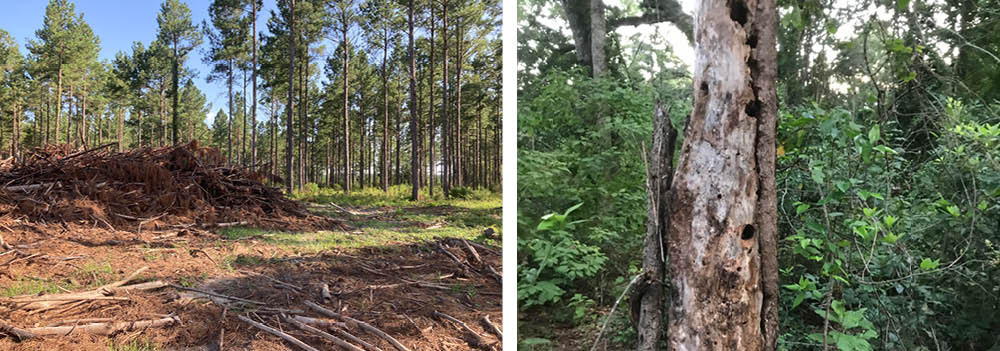
Left: Debris piles from recent logging. Right: Snag retained for wildlife.
Landowners sometimes don’t know about or don’t practice good wildlife management practices. However, regulation, education, and economic incentives all encourage landowners to practice good stewardship of forests. Biologists from DNR, National Wild Turkey Federation, Quail Forever, and Georgia Forestry Commission provide advice and develop wildlife management plans for individual landowners. There are also economic incentives, such as cost sharing under Environmental Quality Incentives Program to encourage practices like thinning, burning, understory restoration, and planting for pollinators.
From an environmentalist perspective, the objective is to maintain a landscape mosaic of diverse habitats with plenty of early-succession ecosystems. According to Erin Cork, DNR wildlife biologist, “Most of the threatened and declining species of wildlife in our region require early successional habitat and have evolved alongside fire. These grass, forb, and shrub dominated understory communities are the types of plant communities that are most scarce in our landscape. By restoring them (or by managing forests and pine stands to include this important component), we are creating habitat for the wildlife species that need the most help.” The combination of timber harvesting and burning creates, not destroys, high-quality wildlife habitats.
|